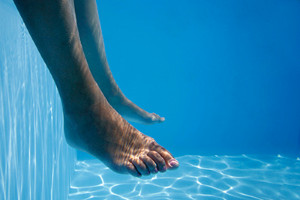Pumice stones are light but abrasive stones that are formed from a mixture of lava and water. They are frequently used to remove dead, dry skin from the feet, especially on the heels. To exfoliate dry heels with a pumice stone, soak your heels in warm water for 5 to 10 minutes. Next, remove your heels from the water and dry them. Wet the pumice stone and then rub the abrasive side of the stone on the dry skin, in a circular motion with light pressure, for approximately two minutes or until the dry skin has been removed. When finished, rinse the pumice stone and apply moisturizer to your feet. Avoid rubbing the pumice stone with too much pressure, as this can injure your feet and lead to cuts, bleeding, and infection. If you have diabetes or other foot problems, you should not use a pumice stone to exfoliate without an okay from your doctor. To learn more about foot care, please consult with a podiatrist.
Cracked heels are unsightly and can cause further damage to your shoes and feet. If you have any concerns, contact one of our podiatrists from Foot Health Center of Merrimack Valley. Our doctors can provide the care you need to keep you pain-free and on your feet.
Cracked Heels
Cracked heels appear unappealing and can make it harder for you walk around in sandals. Aside from looking unpleasant, cracked heels can also tear stockings, socks, and wear out your shoes. There are several methods to help restore a cracked heel and prevent further damage.
How Do You Get Them?
Dry skin is the number one culprit in creating cracked heels. Many athletes, walkers, joggers, and even swimmers suffer from cracked heels. Age and skin oil production play a role to getting cracked heels as well.
Promote Healing
Over the counter medicines can help, especially for those that need instant relief or who suffer from chronic dry feet.
Wear Socks – Wearing socks with medicated creams helps lock in moisture.
Moisturizers – Applying both day and night will help alleviate dryness which causes cracking.
Pumice Stones – These exfoliate and remove dead skin, which allows for smoother moisturizer application and better absorption into the skin.
Change in Diet
Eating healthy with a well-balanced diet will give the skin a fresh and radiant look. Your body responds to the kinds of food you ingest. Omega-3 fatty acids and zinc supplements can also revitalize skin tissue.
Most importantly, seek professional help if unsure how to proceed in treating cracked heels. A podiatrist will help you with any questions or information needed.
If you have any questions, please feel free to contact one of our offices located in North Andover, and Tewksbury, MA . We offer the newest diagnostic and treatment technologies for all your foot care needs.


 itis
itis


 Bunions
Bunions




